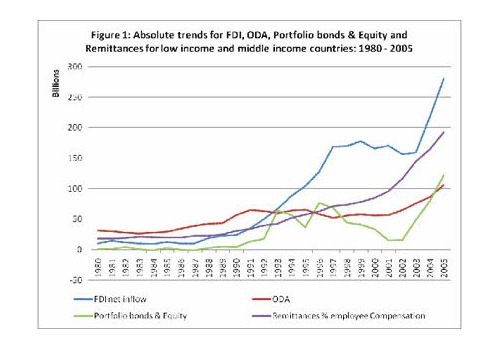About the research
There has been a shift from traditional bank lending to developing countries in the 70s to foreign direct investment (FDI) in the 90s. However, viewed as a group, one may miss the true picture, as over 30 per cent of FDI flows have been to China. Africa continues to lead in attracting foreign aid (about 30 per cent) but aid has either not been enough or is ineffective to growth and poverty reduction. As the world looks towards 2015 when the millennium development goals are expected to be achieved, there is a need to look at other sources of financing. Remittances are currently being discussed as an innovative source which is deemed to be effective as it goes directly into the hands of those in need. The tax on foreign currency transactions or the UK international finance facility and others are thought to serve to increase the amount of aid necessary to help developing countries halve poverty by 2015.
Methodology
Based on the existing literature, we sought to understand the pattern of the traditional flows and the driving force behind them. The availability of the World Bank’s World Development Indicators made the task easier. We used aggregates for all developing countries and then separated them by region and China. From the data we made line graphs to visualise the pattern of the flows. Also, separating by region and big players, we had a better understanding of those flows. After going through this exercise, we also reviewed existing plans for innovative financing.
Results/Outcome
- Though the amount of foreign direct investment to developing countries has increased tremendously during the 1990s, over 30% of it has been to China which has been experiencing high growth rates over the past decade. A continent like Africa which has received less than 10% in the past decade, lags behind in growth and poverty reduction.
- The graphs demonstrate that remittances which is an innovative source of finance is counter-cyclical. That is, during years of crisis, such as the 1994 Mexican crisis and the 1997 Asian Financial crisis when all forms of foreign financing and growth plummeted, remittances instead soared and is the most stable and predictable source of finance for development and poverty reduction.
- Innovative sources of finance are important but the issue that remains to be resolved is that of implementation. A rise in aid to Africa was accompanied by a decline in output and a number of reasons have been advanced prominent amongst which is the administration of aid programmes, an issue which is likely to mar the efforts of some of the new approaches like the UK international finance facility.

Source data: World Bank World Development Indicators (WDI), April 2007, Mimas, University of Manchester.
